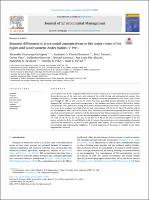Seasonal differences in trace metal concentrations in the major rivers of the hyper-arid southwestern Andes basins of Peru
Metadata
Show full item recordAuthor(s)
Date
2023-10Subject
Andes - Cuenca Hidrográfica - Agua Superficial - Metal - Contaminantes - Mineral - Cuenca Fluvial - CuencasCollections
- Artículo científico [171]
Related Resource(s)
https://www.sciencedirect.com/science/article/pii/S0301479723012811Abstract
The southern rivers of Peru originate in the Andes Mountains and flow in a southwestern direction to the Pacific Ocean through one of the most hyper-arid regions of the world. During each sub-equatorial summer from December to February, rains and snow melt in the Andes increase the streamflow in these rivers, even as they pass through the 100 km arid zone to the ocean. This study quantified seasonal dynamics of 34 trace metal elements (TM) and other constituent concentrations in four southern river basins of Peru (Chili-Quilca, Tambo, Camana-Majes-Colca, and Ocoña) during 2019–2020. Consistent with previous studies, we observed that: (1) the river water in the southern basins had relatively high concentrations of B, As, Fe, Al, Mn, P, Pb and Ni, with As the most ubiquitous toxic TM in all the basins, often detected at concentrations surpassing Peruvian and USEPA regulated concentrations; and (2) basins with the most to least toxic TM contamination were the Tambo > Chili-Quilca > Camana-Majes-Colca > Ocoña. Seasonal streamflow strongly influenced the concentrations of twenty TM, with 15 TM (Al, Au, Ba, Cd, Co, Cu, Fe, Gd, Mn, Ni, P, Pb, Ti, Yb and Zr) consistently higher in the wet season, and with As, B, Ge, Li, and Pd higher in the dry season. Our results improve the understanding of seasonal variability and vulnerability in western Andes superficial water sources, which are highly influenced by both local geogenic and anthropogenic conditions. A Spanish translation of this paper is available in the online Supplementary Material.
The following license files are associated with this item:








